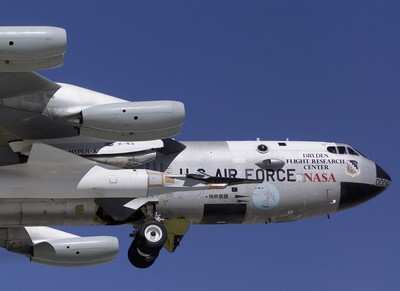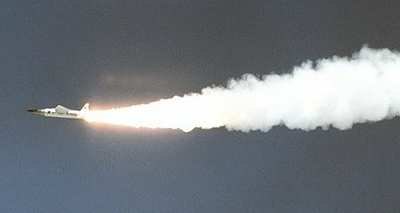Almost Mach 10
It's official. The new world speed record for a jet-powered
aircraft, set by NASA in November, has been officially recognized
by Guinness World Records.

The accomplishment, the third and final flight in the
experimental X-43A project, demonstrated that an advanced form of
air-breathing (jet) engine could power an aircraft at nearly 10
times the speed of sound. Data from the unpiloted, 12-foot-long
research vehicle show that its revolutionary "scamjet" engine
worked successfully at Mach 9.6 or nearly 7,000 mph, as it flew at
about 109,000 feet over the Pacific Ocean west of California.

The flight was the culmination of NASA's Hyper-X Program, a
seven-year, approximately $230 million ground and flight test
program designed to explore an alternative to rocket power for
space access vehicles.
This is the second world speed record earned by the Hyper-X
Program. The first came following its Mach 6.8 (nearly 5,000 mph)
flight in March of 2004, which easily shattered the previous,
long-standing record. Both records will be featured in the 2006
edition of the Guinness World Records book, which will be published
in September of this year.
NASA is interested in supersonic combustion ramjet (scramjet)
technology because scramjet engines get their oxygen from the
atmosphere allowing more airplane-like operations for increased
affordability, flexibility and safety in ultra-high-speed flights
and for the first stage to Earth orbit. Once a scramjet-powered
vehicle is accelerated to about Mach 4 by a conventional jet engine
or booster rocket, it can fly at hypersonic speeds, possibly as
fast as Mach 15, without carrying heavy oxidizer, as rockets
must.

A ramjet operates by subsonic combustion of fuel in a stream of
air compressed by the forward speed of the aircraft itself, as
opposed to a normal jet engine, in which the compressor section
(the fan blades) compresses the air. A scramjet
(supersonic-combustion ramjet) is a ramjet engine in which the
airflow through the whole engine remains supersonic.

"These demonstrations proved the viability of scramjet engine
technology in a "real-world" flight environment and were the result
of over 40 years of high speed propulsion research within NASA,"
commented Dryden's Paul Reukauf, who served as deputy project
manager for the X-43A flight research and testing.
The new Guinness World Record certificate reads:
"On 16 November, 2004, NASA's unmanned Hyper-X (X-43A) aircraft
reached Mach 9.6. The X-43A was boosted to an altitude of 33,223 m
(109,000 ft) by a Pegasus rocket launched from beneath a B52-B
aircraft. The revolutionary 'scramjet' aircraft then burned its
engine for around 10 seconds during its flight over the Pacific
Ocean."

Related flight records include:
- The previous known record for an air-breathing vehicle -- but
not an airplane -- was held by a ramjet-powered missile, which
achieved slightly more than Mach 5.
- The highest speed attained by a rocket-powered airplane, NASA's
X-15 aircraft, was Mach 6.7.
- The fastest air-breathing, manned vehicle, the SR-71, achieved
slightly more than Mach 3.2. The X-43A more than doubled, then
tripled, the top speed of the jet-powered SR-71.

The Hyper-X program was conducted by NASA's Aeronautics Research
Mission Directorate with the NASA Langley Research Center, Hampton,
VA, as lead center with responsibility for hypersonic technology
development and the NASA Dryden Flight Research Center, Edwards,
CA, responsible for flight research and testing.
 ANN's Daily Aero-Term (04.28.24): Airport Marking Aids
ANN's Daily Aero-Term (04.28.24): Airport Marking Aids Aero-News: Quote of the Day (04.28.24)
Aero-News: Quote of the Day (04.28.24) ANN's Daily Aero-Linx (04.28.24)
ANN's Daily Aero-Linx (04.28.24) Aero-News: Quote of the Day (04.29.24)
Aero-News: Quote of the Day (04.29.24) ANN's Daily Aero-Linx (04.29.24)
ANN's Daily Aero-Linx (04.29.24)








